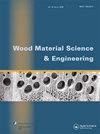Increasing efficiency of an industrial robot when machining timber beams – introduction of a parametric solving model to determine optimised stacks
IF 2.1
3区 农林科学
Q1 MATERIALS SCIENCE, PAPER & WOOD
引用次数: 0
Abstract
ABSTRACT The aim of this study was to increase the economic efficiency of industrial robots (IR) when subtractive machining timber beams. The most compact possible stack configuration, consisting of three different workpiece geometries, was calculated and machined. When compared to machining individual workpieces, a reduction of the process time is strived for. The workspace of the IR should be fully utilised by an optimised spatial stack configuration (number, location and spacing of workpieces). The stacks were calculated using a parameterised evolutionary solver model in Rhinoceros, Grasshopper, Galapagos and Opossum software. Machining trials were performed to obtain process time data for the IR and as a reference for a benchmark joinery machine (JM). By applying the newly introduced optimisation model, the process time per workpiece, when machining stacks instead of individual specimens, was reduced by 16%. This result was primarily achieved by shifting the share of non-machining time to machining time. When compared to individual machining with a JM, the process time of the IR is still higher. This fact can be outweighed by advantages of IRs such as cost, availability and flexibility, showing that the overall economic efficiency of IRs does in fact hold potential for prefabrication in the timber construction sector.提高工业机器人在加工木梁时的效率——引入参数求解模型来确定优化堆栈
摘要本研究的目的是提高工业机器人在减法加工木梁时的经济效率。计算并加工了由三种不同工件几何形状组成的最紧凑的堆叠结构。与加工单个工件相比,力求缩短加工时间。IR的工作空间应通过优化的空间堆栈配置(工件的数量、位置和间距)来充分利用。使用Rhinoceros、Grasshopper、Galapagos和Opossum软件中的参数化进化求解器模型计算堆栈。进行机械加工试验以获得IR的工艺时间数据,并作为基准细木工机械(JM)的参考。通过应用新引入的优化模型,当加工堆叠而不是单个试样时,每个工件的加工时间减少了16%。这一结果主要是通过将非加工时间的份额转移到加工时间来实现的。与使用JM的单独加工相比,IR的处理时间仍然更高。IRs的成本、可用性和灵活性等优势可以抵消这一事实,这表明IRs的整体经济效率实际上在木材建筑行业具有预制的潜力。
本文章由计算机程序翻译,如有差异,请以英文原文为准。
求助全文
约1分钟内获得全文
求助全文
来源期刊

Wood Material Science & Engineering
Materials Science-General Materials Science
CiteScore
3.90
自引率
13.60%
发文量
131
审稿时长
79 days
期刊介绍:
Wood Material Science and Engineering is a multidisciplinary and international journal with the aim to serve at the forefront of the wood science and technology field. The journal publishes original articles on basic and applied research dealing with:
-Wood material science with emphasis on: water-wood relations, wood durability, wood modification, wood mechanics, wood composites, engineered wood products, energy conversion and eco-efficient wood based products.
-Wood engineering, i.e. the application of the wood material science to designing, processing and manufacturing of forest products and the use of machines and processes for these products. Products of concern are biofuels, sawn wood and further refined products such as structural elements, interior fittings and furnishings. In this aspect the link between the nature of the wood material and the properties of the final wood products in-service and its impact on the environment is of outmost importance.
High quality review papers may also be accepted but the topic should be discussed with the editor before submission.
 求助内容:
求助内容: 应助结果提醒方式:
应助结果提醒方式:


